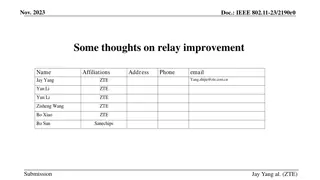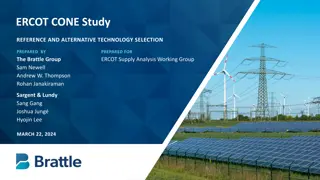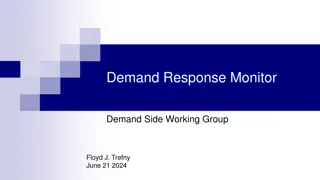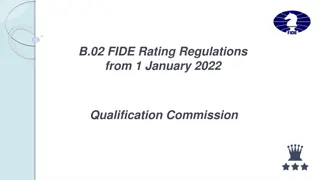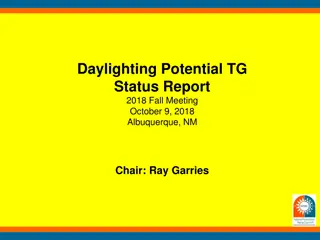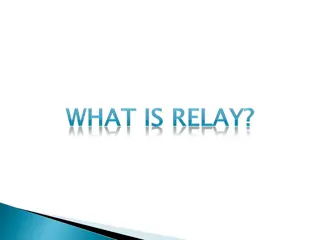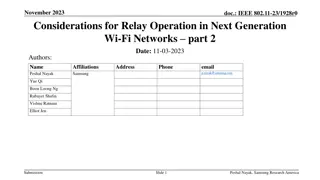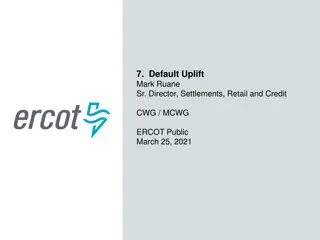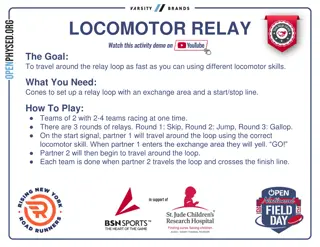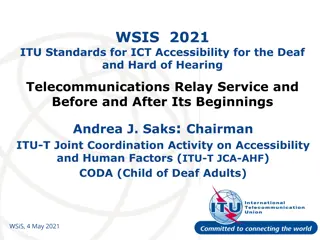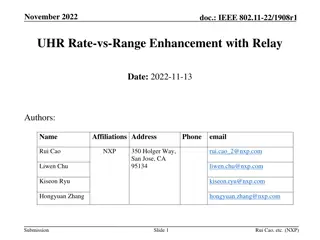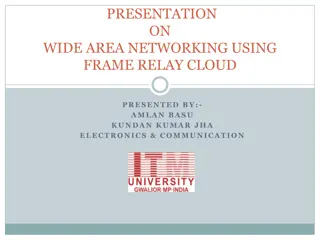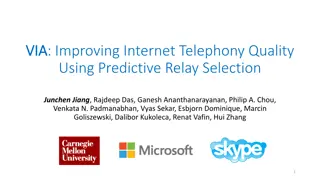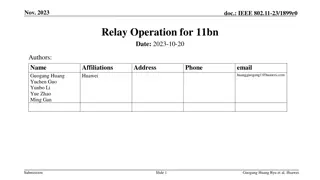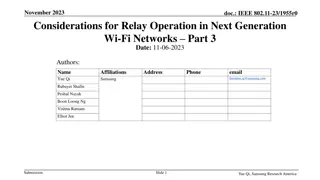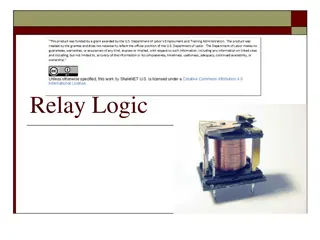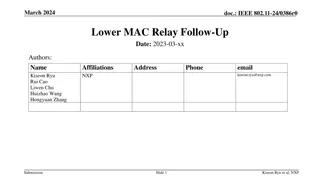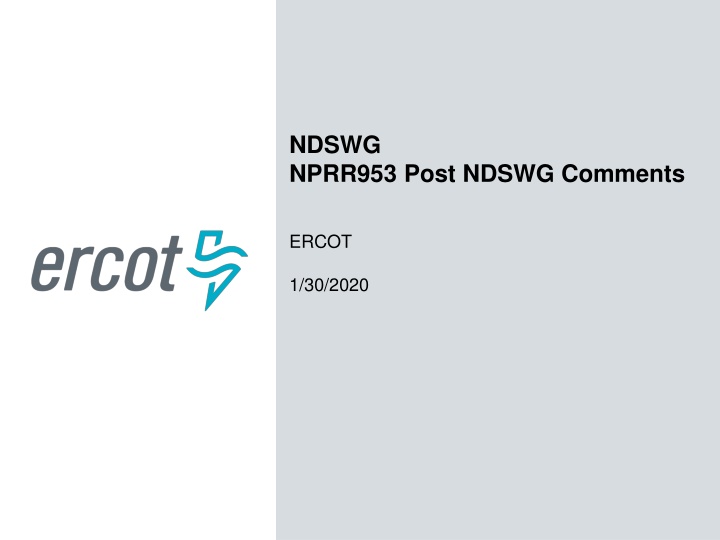
Review of ERCOT Comments and Proposals on NDSWG NPRR953
Explore the review and proposals by various entities like Oncor, CNP, and AEP regarding ERCOT comments on NDSWG NPRR953. Discussions include the removal of terms like "Actual" and proposals for new values in Planning and Operations models. Oncor's detailed justification for a 150% threshold and processing guidelines are also highlighted.
Download Presentation

Please find below an Image/Link to download the presentation.
The content on the website is provided AS IS for your information and personal use only. It may not be sold, licensed, or shared on other websites without obtaining consent from the author. If you encounter any issues during the download, it is possible that the publisher has removed the file from their server.
You are allowed to download the files provided on this website for personal or commercial use, subject to the condition that they are used lawfully. All files are the property of their respective owners.
The content on the website is provided AS IS for your information and personal use only. It may not be sold, licensed, or shared on other websites without obtaining consent from the author.
E N D
Presentation Transcript
NDSWG NPRR953 Post NDSWG Comments ERCOT 1/30/2020
Topics Review of Comments ERCOT s Comments New ME Draft 2 PUBLIC
Topics Review of Comments ERCOT s Comments New ME Draft 3 PUBLIC
Review of Comments Oncor: Propose removing Actual since ERCOT has stated it is not defining the calculation methodology. Some TSPs may intend to use PRC-023 values. CNP: CNP supports Oncor and AEP in removing the term Actual as entities will likely be utilizing different calculation methodology. AEP: AEP agrees with Oncor sproposal to remove Actual 4 PUBLIC
Review of Comments, Cont AEP: Propose using a value that the Planning and Operations models do not currently use to denote or flag an error in a model run. 5 PUBLIC
Review of Comments, Cont ONCOR: 150% is sufficiently conservative for the actively maintained level. The periodically maintained should be on an annual basis. Oncor congestion/constraint tracking data shows that from 12/1/2010 to present, there were 44 events that exceeded 150% of the Emergency/2 Hour rating, for a total of 8,715 minutes. This equates to 0.18% of the time when averaged from 12/1/10 to present. Theoretical analysis/justification for 150%: The probability of a post-contingency loading exceeding 150% is very low. The probability of a relay setting change in a calendar year reducing loadability within the 200% - 150% range is also very low. The probability that a post-contingency loading issue is related to a specific relay that had its loadability reduced within the calendar year is also extremely low. The probability of all three of these items happening concurrently is extremely, extremely low. Therefore, 150% of the Emergency/2 Hour Rating is sufficient for the Actively vs Periodically maintained distinction. Oncor s proposed changes also align with industry and NERC accepted requirements contained in PRC-023. 6 PUBLIC
Review of Comments, Cont ONCOR: We request that the document describe what is expected to be processed through normal NOMCR vs interim NOMCR vs DPC. From the January 6 workshop, Oncor s understanding was that ERCOT would classify the changes as follows: If RLR is changed to become <125% of Load Shed/15 minute rating, TSP would process the change through DPC. If RLR change occurs, but new value is >125% of Load Shed/15 minute rating, TSP would process as follows: Minor changes would be processed through normal NOMCR; Significant changes (value falls below PRC-023 calculated value of 150% of Emergency/2 Hour Rating) would be processed through Interim NOMCR. 7 PUBLIC
Review of Comments, Cont AEP: AEP agrees that the periodically maintained should be at least annually. AEP prefers the Emergency Rating, however, our main concern is to maintain consistency by referring to only one of the rating levels for all the decision points, and that mixing emergency and 15 minute ratings should be avoided. Because the decision mark to perform a Cascading Analysis is at 125%, we believe that 125% of the Emergency/2 Hour Rating for BES and non BES Transmission Facilities is appropriate for both Periodically and Actively Maintained RLRs. The sag response time is actually less than an operator response time if preloaded to 75% and post-contingency will be above this 125%. In other words, the line is likely to sag into something even though the relays would not operate because of loadability settings. Consequently, it s likely that RLRs >125% would not be the defining decision driver. That said, AEP appreciates Oncor sviewpoint that 150% is sufficiently conservative for the actively maintained level. We suggest that consistency across the levels is an important consideration and could benefit from additional discussion. AEP requests clarity about what is expected to be processed through NOMCR, Interim NOMCR or DPC. In general, AEP believes that if the RLR is decreasing, the change should be submitted immediately via DPC, while increases in the RLR could be submitted on a different timeline through the various NOMCR processes. We offer the following for consideration and discussion: If the RLR is changed to become 125% (or 150% if that is the rating level settled upon for the table) of the Emergency/2 Hour Rating, the TSP would process the change through DPC only if the RLR is decreased for existing facilities. If the RLR is changed and the new value is >125% (or 150% if that is the rating level settled upon for the table) of the Emergency/2 Hour Rating, the TSP would process the changes so that: Minor, or increased, RLR changes are made at least annually Significant changes (value falls below PRC-023 calculated value of 125% of Emergency/2 Hour Rating) are made through Interim NOMCR. 8 PUBLIC
Review of Comments, Cont CNP: CNP generally supports the comments by Oncor and AEP for an annual submittal rather than quarterly submittal. As stated in our previous comment above, CNP believes that actively maintaining the relay loadability is not warranted given the unlikely circumstances of a relay loadability reduction and would prefer an annual refresh of the values submitted. 9 PUBLIC
Review of Comments, Cont CNP: CNP does not have branches with in-line breakers that do not have relaying. If this is also the case with all other TSPs we recommend removing this example. Additionally, there is an adequate example of a branch that is not monitored by relay indicated in Example 2 between tap positions such as Station X and Station Y. 10 PUBLIC
Review of Comments, Cont CNP: Update examples to state Value instead of Actual since the term Actual is recommended to be removed. 11 PUBLIC
Review of Comments, Cont CNP: CNP believes at a minimum ERCOT should specify a voltage and load angle by which entities must submit values. Although we realize these details likely do not belong in the Modeling Expectations, we believe it would be beneficial for ERCOT to define these parameters for the purpose of consistency among TSPs. CNP would prefer to have a single, annual submittal of relay loadability ratings. The initial submittal per ERCOT s request and an update at least annually for any changes to relay settings. CNP finds it highly unlikely for any relay settings changes to result in reduction in relay loadability. While not impossible, CNP normally installs microprocessor based systems that have supplemental features to enhance relay loadability. Currently there is no mechanism in place in our current Operations Model update process to track and compare every relay settings change to ensure that it doesn t impact a previous relay loadability threshold as is suggested in this document. CNP believes that this increased burden is not warranted given the unlikely circumstances of a relay loadability reduction and would prefer an annual refresh of the values submitted. Additionally, for any new positions entities would need to submit relay loadability prior to energization. 12 PUBLIC
Topics Review of Comments ERCOT s Comments New ME Draft 13 PUBLIC
ERCOTs Comments 14 PUBLIC
Topics Review of Comments ERCOT s Comments New ME Draft 15 PUBLIC
Open Discussion 16 PUBLIC

